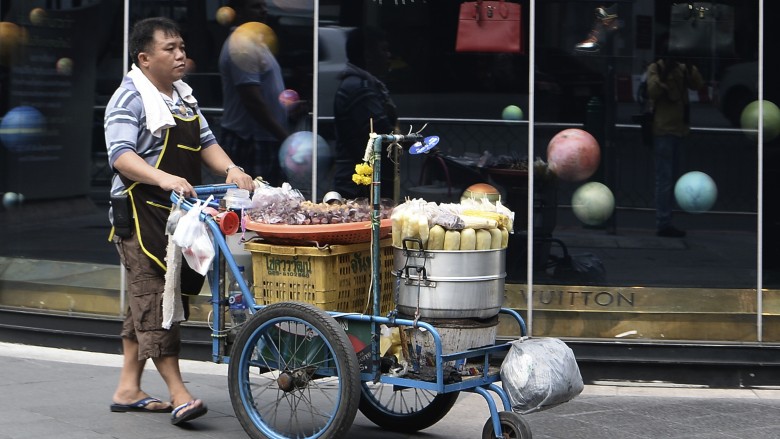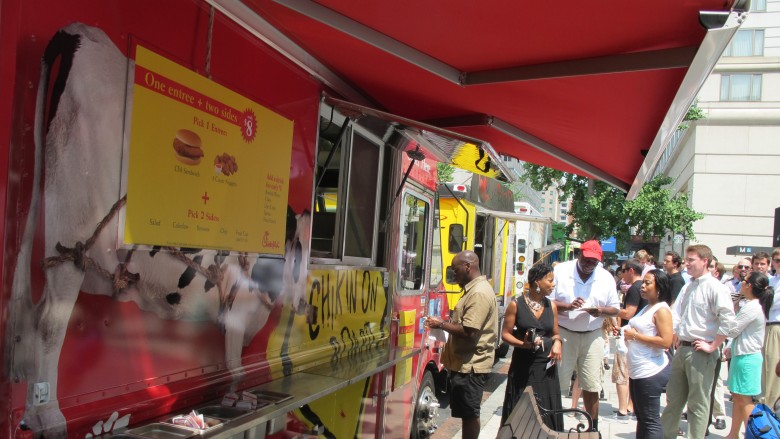The Untold Truth Of Food Trucks
Falafel at 2 in the morning after a concert. A cheeseburger with seasonal jam in a parking lot in Santa Barbara. A quintessential New York hot dog with mustard and sauerkraut. A short rib taco on the streets of Los Angeles. Jackfruit tacos at a music festival. Each of these conjures a distinct memory for me as I can remember the settings, the smells, and the flavors of these iconic food truck experiences in America. These days, you'd be hard pressed to find a city without a solid cadre of food trucks serving lunch, dinner, and late-night snacks to its working and partying populations. These movable feasts join brick-and-mortar restaurants in Zagat ratings and hype alike. But the food truck phenomenon in the U.S. is relatively recent, thriving in a post-recession, socially networked world. So what's the real story behind these delectable, mobile restaurants? A bit of digging exposes the history of this new gourmet movement.
They've been around for a long time
Before there were food trucks as we in the contemporary United States conceive of them, there were all kinds of food carts, wheelbarrows, trucks, and open-air stalls around the world serving up street food. Portable food vendors have been around for as far back as ancient Mesopotamia, so it's safe to say that hipsters lining up for artisan flatbread is just the most recent face of this global, longstanding food tradition. An estimated 2.5 billion people in an array of countries rely on this food in some way today, whether for basic sustenance or for an occasional snack. The vast majority of this commercial food is what we would call fast food, that is, food items prepared quickly and repeatedly from prepared ingredients. In many cases, this fast food is not designed to be healthy and could even be considered junk food. Mostly you'll find grilled meats or sweet treats. You're also likely to find vendors serving up hearty, regional dishes.
They're a boon for local economies
The mobile food movement formed organically, created by regular folks who needed to make a living. They sold food that was inexpensive but tasted good. In turn, people who needed to feed themselves on a budget turned to these vendors for sustenance, and the demand created the supply. This fostered an interdependence that was a boon for many local economies, keeping people out of poverty and providing food security to the potentially food insecure. In fact, many poor folks in places like Asia depend exclusively on mobile food vendors for almost all their food needs.
How food trucks started in the U.S.
The food truck movement of recent years was not conceived at a Silicon Valley foosball table, nor was it orchestrated at a boardroom table in a Manhattan high-rise. Before cars and trucks dotted the American landscape, there were chuck wagons and push carts serving food to rural cowboys starting in the 1860s and urban workers as early as the 1870s. Chuck wagons were popular in rural areas, serving cooked breakfast, lunch, and dinner to men working the plains. Pushcarts, on the other hand, served simple, cold meals to workers in urban areas who needed cheap sustenance to get through the day. Both of these served as predecessors to the modern food truck, paving the way for a variety of street vendors such as the iconic hot dog cart and ubiquitous submarine sandwich stand. And once the automobile was finally invented, mobile food vendors like ice cream trucks became part of American food culture, playing the siren song of sugar that lures children outside in the summer to this day.
Where food goes, gourmet food soon follows
Some mobile food vendors feel to me like they've always been around, like hot dog carts, tamale carts, ice cream trucks, and soft pretzel kiosks. But when I was growing up and coming of age in New York, there were no food trucks serving gourmet cheeseburgers or edgy ethnic fusion dishes. So what happened to drive the rise of gourmet food trucks? In a nutshell, an economic shift. First, the Great Recession put a number of restaurants out of businesses. As restaurants closed, skilled chefs found themselves out of work, looking for innovative ways to make money and stay employed. Couple that with the collapse of the construction industry, which left construction site food trucks without customers. With the economy collapsing and brick-and-mortar establishments too expensive to open, the modern food truck emerged as a viable business option. And with a glut of used food trucks for sale, the perfect storm was brewing.
Social media changes the game
Aside from the chefs, the trucks, and the food staples, there was another key ingredient that fueled the rise of the gourmet food truck revolution in the US: social media. Rather than sit at fixed spots or compete with other trucks at busy locales for business, food truck operators began to utilize Twitter, Instagram, and Facebook to share their location with potential customers. And it was wildly successful for many. Some chefs amassed thousands of followers, tweeting their daily location, menu options, and even parking tips for loyal customers. With social media, mobile food vendors didn't need to rely on traditional advertising or other publicity methods to get the word out about their gourmet creations.
They're a stepping stone to brick-and-mortar
Most chefs who open a food truck don't envision themselves working in a food truck forever. Rather, owning and operating a food truck is a means to an end: opening a brick-and-mortar restaurant. It's not surprising, given how much lower the cost of opening a food truck is versus the expense of opening a brick-and-mortar restaurant. In fact, it's become a way for chefs to market and establish their unique brand without spending years working for another person, the typical path for emerging cooks. This independence combined with the lower cost of operations has created a glut of high-quality mobile food establishments. This is not to say that owning and operating a food truck is an easy enterprise, however; in fact, there are a lot of potential pitfalls in the business. But as long as you plan your strategy, finance your operation accordingly, execute a good product, and run into a little bit of luck, you'll do well in the food truck business.
Starting with a food truck allows entrepreneurs to build a brand, attract followers, and perfect dishes with a fraction of the overhead and risk that traditionally comes with opening a restaurant. Once a food truck is solvent, the chef can take the recipes, capital, and followers and translate that success into a more permanent establishment. Plus, owning and operating a food truck can help chefs learn how to run a business, preparing them for restaurant ownership. And while not every food truck owner will have the success of Roy Choi, certainly smart entrepreneurs can establish a good business that will sustain itself once it's no longer on wheels.
It's a tough business
Just because opening and operating a food truck is cheaper than a brick-and-mortar restaurant doesn't mean it's an easy enterprise by any stretch, especially in the United States. This is especially true if the food truck operates in areas with potentially excessive rules and regulations. Also, there's a lot of competition out there in major metropolitan areas, which is where the bulk of business can be found. There's also the cost of insurance, which can be pretty pricey and usually fairly complicated to purchase. To top it off, food truck owners work long hours and have to deal with uncertain weather patterns, which can put a crimp in business unpredictably. Examining the business holistically shows how much time, effort, money, and nuance is required to be successful; the food truck industry is not as simple or profitable as it may seem on the surface.
Food safety is serious
Another important issue that can make or break a food truck is food safety. Just as any restaurant or food establishment is subject to rigorous food safety protocol in the US, so are mobile food vendors. However, some argue that maintaining food safety standards on a food truck is more difficult than it is in standard brick-and-mortar establishments. This makes sense given the smaller confines, water tank maintenance, and fluctuating electricity sources. Fortunately for consumers, there's a way to check up on food trucks in your area to find out if they make the grade. There are also ways to gauge the cleanliness of a food truck just by looking at it and observing how it's maintained. In the end it behooves both owner and customer to have a clean establishment, so for the most part food trucks are safe. And that's good news.
They've gone mainstream
As food trucks have become part of the common fabric of American culture, it's only natural that they have become more and more mainstream. You'll still find innovative, independent, gourmet food trucks in major metropolises in the US, even as the most successful trucks go brick-and-mortar. But you'll also find that some corporate, brick-and-mortar establishments are opening food trucks in a reversal of the earlier observed trends, attempting to cash in on the food truck revolution. Iconic fast-food restaurant Chick-fil-A runs a small but growing fleet of food trucks in Washington D.C. and beyond. Starbucks launched a fleet of trucks in 2014 on college campuses. Even companies like Burger King, and TGI Friday's have launched mobile food vendors in the last few years with varying degrees of success. And while many of these corporate enterprises have not thrived, the very fact that they tried shows that food trucks have arrived with confidence into the mainstream.









